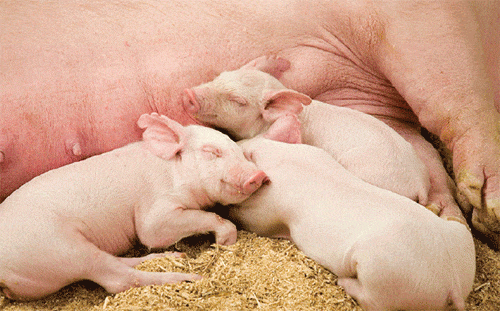Xaviera Louw, monogastric technical advisor, Meadow Feeds
The weaning process is the most significant event in the piglet’s life as they are forced to adapt to immunological, nutritional and psychological disruptions. This stressful period is associated with depressed feed intake, sub optimal growth and an increased incidence of diarrhoea.
At weaning piglets are susceptible to numerous viral and bacterial diseases, which can be caused and accelerated by dietary components within the diet. Depending on the solubility, viscosity, solubility and acid buffering capability of the raw materials it can prevent or promote the proliferation and colonisation of pathogens in different parts of the intestine.
These diseases include post-weaning colibacillosis caused by serotypes of enterotoxigenic Escherichia coli, salmonellosis caused by Salmonella S., proliferative enteropathies caused by Lawsonia intracellularis, swine dysentery caused by Brachyspira hyodysenteriae and porcine intestinal spirochaetosis caused by Brachyspira piloscicoli. The post-weaning colibacillosis normally occurs two weeks after weaning and the other diseases four to six weeks post weaning.
The piglet has to adapt from the sows’ milk to a less digestible starch diet. The milk is high in protein, fat and lactose. Nursery diets for piglets before and after weaning normally contain high crude protein levels to meet their high amino acid requirements. These high crude protein levels may sometimes exceed the requirements of the piglet and do more harm than good.
At weaning, the piglet’s ability to absorb and digest high protein diets can be limited because the pancreatic brush border enzymes systems are not fully developed. Undigested proteins and endogenous proteins (proteins which already exist as components of living cells) can cause bacterial fermentation in the lower small intestine and the large intestine. Consequently, as the intestinal pH increases, pathogen proliferation and production of intestinal irritants such as ammonia are produced. One of the most important risk factors in the occurrence of post-weaning E. coli infections have been identified as the subsequent fermentation on pathogen proliferation and intestinal barrier function during the immediate post-weaning period.
Low protein levels for piglets immediately after weaning can sometimes be dangerous because levels without the correct balance of supplemented crystalline amino acids can comprise growth. However, the use of low protein diets supplemented with crystalline amino acids can increase the cost of the feed. These crystalline amino acids refer to lysine, methionine, threonine and tryptophan. By supplementing these amino acids, the dietary concentration of protein can be reduced by 3-4% while maintaining dietary levels of the essential amino acids at or above the requirement of the piglet. This strategy significantly reduces scouring without reducing piglet performance.
Another strategy would be to reduce the protein level for five to seven days post weaning. This will minimise the incidence of scouring. After seven days, the piglets can consume a standard protein diet again. However, this can have an effect on performance but most likely can be compensated for by the pigs because of the short period of protein restriction.
The dietary level and the source of protein can influence the gut health in the piglets. There are certain raw materials such as leguminous plant proteins, for example soybean meal and peas. These sources are known to have a negative impact of the health and the growth of the piglets post weaning.
Diets based on soybean meal and other legumes reduce the duodenal activities of most intestinal enzymes and the total tract digestibility of energy and nitrogen. Compared to animal proteins such as dried skim milk, soybean meal results in a transient allergic reaction in early-weaned pigs.
The processing of plant proteins are known to improve the digestibility of the raw materials. Feeding processed soybean products such as microbial fermented soy bean meal can increase the number of intestinal lactobacilli (good bacteria), decrease the number of enterobacteria and increase the villi height as well as the villi height and crypt depth ratio compared to conventional soybean meal.
Animal protein sources are of better value compared to plant proteins when fed to weaned piglets. This is partly due to the fact that plant proteins are less digestible than animal proteins. Plant proteins have different structural characteristics and anti-nutritional factors are present. The feeding of animal proteins such as whey protein concentrate and fish meal result in better growth performance, gut morphology and nutrient digestibility. The quality of the protein source is also very important. Protein sources such as soybean meal must be heat-treated prior to the inclusion in pig diets. Anti-nutritional factors are present in soybeans and may limit the growth of the piglets. The fermentation and enzyme treatment eliminate or can reduce the allergenic proteins and oligosaccharides (carbohydrates that contain simple sugars).
In conclusion, the protein level, protein source and the quality of the protein in post weaning diets have a significant impact on the intestinal health and therefore the growth performance of the piglet. Careful consideration of feed ingredients and nutrient levels should be maintained in order to make the weaning transition from milk to feed as easy as possible. *References available on request.
The South African Pork Producers’ Organisation (SAPPO) coordinates industry interventions and collaboratively manages risks in the value chain to enable the sustainability and profitability of pork producers in South Africa.
















